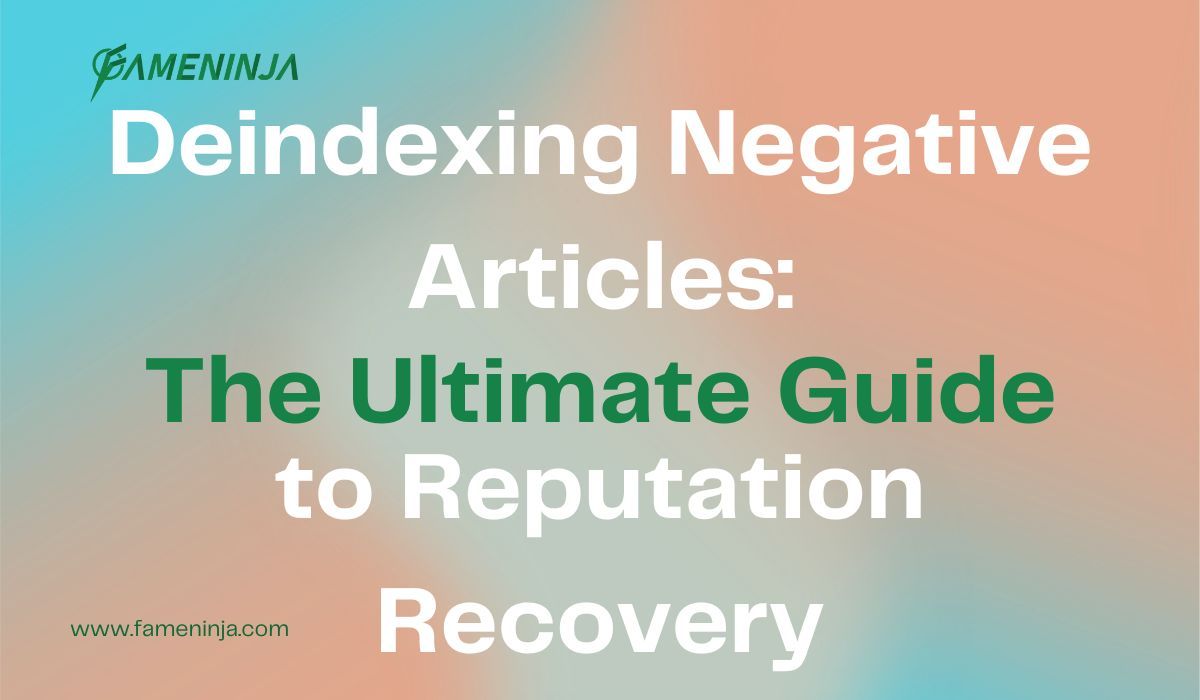
The internet never forgets—or so it seems. When negative articles appear in search engine results, they can haunt individuals and businesses for years. Even if the information is outdated, misleading, or completely false, it continues to affect reputations, job opportunities, and business success.
Deindexing negative articles is a critical strategy for online reputation management (ORM), but it’s often misunderstood. Many believe it’s just about filing takedown requests, but the reality is far more technical and strategic.
In this in-depth guide, we’ll explore:
✅ How search engines index and rank content
✅ The technical process to deindex negative articles
✅ Ethical and legal considerations
✅ Real-world case studies demonstrating successful deindexing negative articles
Before we talk about how to deindex negative articles, it’s essential to understand how Google indexes content.
Google’s ranking system is based on three core processes:
🔹 Crawling – Google’s bots (spiders) scan the internet for new content.
🔹 Indexing – The content is stored in Google’s database, ready to be ranked.
🔹 Ranking – Google determines the relevance, quality, and engagement metrics of a webpage before showing it in search results.
Negative articles often rank well due to:
✔ Domain Authority – News sites and review platforms have high credibility.
✔ Backlinks – If a negative article is widely shared, it strengthens its ranking.
✔ Engagement Metrics – The more people click, read, and share, the more Google pushes it up.
To successfully deindex a negative article, you need to break its connection with Google’s ranking system—either by making it less valuable or by triggering Google’s deindexing mechanisms.
There are two primary methods to deindex a negative article from search results:
The most straightforward approach is to ask the website owner to remove or modify the article. This works when:
✔ The article contains false, misleading, or outdated information.
✔ You have legal grounds (defamation, privacy violations, copyright infringement).
✔ The publisher is open to negotiations (e.g., through PR efforts or reputation management).
If this fails, move to technical deindexing negative articles strategies.
One of our clients had a strong reputation on Google, but a false case resulted in six negative articles being published online. Before coming to us, they hired other ORM agencies that tried to suppress the articles. However, over time, the negative content kept returning to the first page of Google.
When they approached our ORM agency, FameNinja, we applied a deindexing approach and a direct outreach strategy to website owners. Here’s how it worked:
📌 Within one month, we successfully removed two articles.
📌 Within three months, we removed four articles.
📌 Within six months, we removed all six articles and fully restored the client’s reputation.
The key to success was patience and trust in our process. By the end of our campaign, our client’s online reputation was fully restored, and no negative articles resurfaced.
Google provides official removal tools for specific cases:
✅ Google’s Removal Tool – If content contains sensitive personal data (e.g., addresses, financial info), you can request Google to remove it. Request Removal Here
✅ Copyright Takedown (DMCA) – If an article includes copyrighted material, a DMCA complaint can get it removed.
🔹 Pro Tip: Google rarely deindexes content just because it’s negative. You need a strong case, such as a privacy violation or legal issue, to succeed.
A client who was the founder of a company was targeted by two ex-employees who had joined a competitor. They spread negative content on nine different platforms, including free Web2 sites and social platforms, using multiple posts and articles to damage the client’s reputation.
📌 Before coming to us, they had already attempted removal activities but failed.
📌 We implemented a deindexing negative article strategy using DMCA takedown requests and Google’s reporting tools.
📌 Within five months, we removed content from seven platforms.
📌 For the two remaining platforms (which could not be removed via DMCA or Google reporting), we used SEO suppression techniques to push them below Page 4 of search results.
🚀 Results: Both the founder and the company fully restored their reputation, and their business credibility was regained.
❌ Myth 1: Paying Google Can Remove an Article
✅ Truth: Google does not offer a paid removal service. If someone offers to “delete” content for money, it’s a scam.
❌ Myth 2: Negative Articles Disappear Over Time
✅ Truth: Unless actively deindexed or suppressed, negative content can stay on Google for years.
If direct removal and Google reporting do not work, you can weaken a negative article’s ranking by:
📌 Burying It – Publishing high-quality content to outrank the negative article.
📌 Removing Backlinks – Contacting sites linking to the negative article and requesting removal.
📌 Google’s Expired Content Tool – If a page is deleted but still appears in search results, this tool speeds up the deindexing process.
With AI-powered search evolving, deindexing negative articles may become more complex. Google is increasingly fact-checking content, using AI to determine credibility.
🔹 AI-driven reputation management tools now monitor and suppress negative content.
🔹 Decentralized search engines (e.g., Brave, Presearch) may change how content ranks in the future.
📌 Expert Insight: Google is tightening deindexing rules, meaning proactive reputation management will become even more crucial.
To successfully deindex negative articles, you need technical expertise, strategic planning, and persistence. While full removal is rare, you can effectively suppress, weaken, or deindex negative content through:
✔ Direct removal (best when possible)
✔ Legal strategies (DMCA, Google’s privacy policies)
✔ SEO suppression (burying negative content under high-ranking positive pages)
✔ AI-driven monitoring for long-term reputation protection
If a negative article is damaging your reputation, acting fast and strategically is the key to minimizing long-term harm.

Fameninja a full service marketing agency getting ahead of the curve. Grab your fair share your of attention captitave and charm your audience with our proven creative capabilities conceptualization and market-analysis, planning and strategy, business and distribution both digital as well as social.